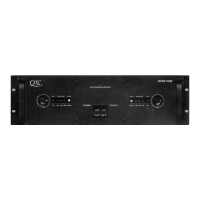34
a. Select an 8-ohm load.
b. Change the input frequency to 20kHz and decrease the input level to 20dB. Adjust the
crossover trimpot, T1, for 3 CM peak-to-peak of crossover spike protruding from the noise
signal on channel B of the oscilloscope. Note: The bias shouldn’t need adjusting unless the
amp is over-heating or the drivers have been changed.
c. Switch the load to 8 ohms and vary the amplifier gain just above and below the step switching
level. Watch for obvious step oscillation. This test must be done when the amplifier channel is
cold since any tendency to instability will disappear as the amplifier warms up. You may
experience a severe glitch on the negative step, which can be corrected by barely turning up
the crossover trimmer. Verify that positive and negative peaks go into step switching within 3
volts peak of each other.
8. 20kHz distortion
a. Select a 4-ohm output load.
b. Check that the distortion is no greater than 0.1% at all output levels from –20dB (2.15 watts) to
full output and not greater than 0.12% at full rated power (215W x 2).
9. 4 ohm power output and frequency response
a. Switch the distortion analyzer to volts/power. Select a 2kHz signal input to the amplifier.
b. Adjust the amp gain to obtain 215 watts (x2), or –7.5dB, output and observe power output at
20Hz (-0.5dB max.), and 20kHz (-0.5dB max.).
10. Temperature cycle
a. Switch to the 2-ohm load. Increase the signal to the point of clipping and short the output of the
amplifier. The clip LED should be on. Check for recovery into 2 ohms (cold).
b. Check the IC rails (5 to 7VDC & ±1VDC).
c. After 1 to 3 minutes the Temp LED should start flashing and 2 to 3 minutes later the
signal/mute relay should go off and the power/protect LED should turn red. Check (with
temperature probe) the turn-off temperature at the PTC. This temperature should be 100°C, ±
5°C. Check that the idle current is not more than 1.0 amps and that it decreases to less than
0.7 amps as the amplifier cools.
d. When the amp resets, observe the short circuit current limited operation (4.0A – 5.5A) into a
shorted output (hot). Test amp recovery (hot) from a short into a 2-ohm load.
e. Set the load resistance to 8 ohms. Decrease the input signal and check for presence of a step
glitch at 100W, ± 10W.
11. Final Check
a. For the signal to noise test, adjust the output for 300W (-6 dB). Remove the input signal and
measure the noise level. The residual noise level must be no more than 5mV on the
oscilloscope.
b. Reduce the Variac voltage. Observe the relay dropout at about 20VAC (± 10V).

